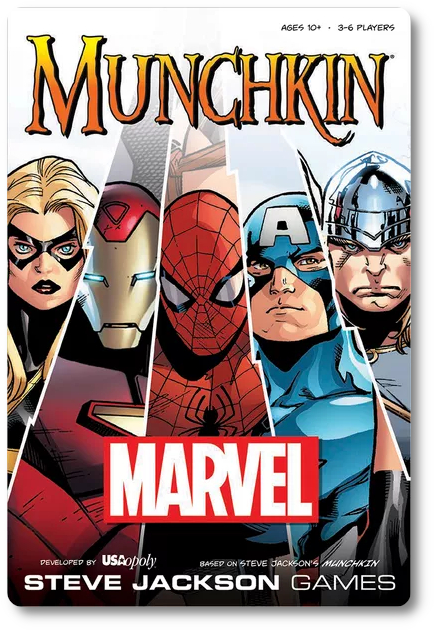
The Basics:
- For ages 10 and up
- For 3 to 6 players
- Approximately 120 minutes to complete
Geek Skills:
- Active Listening & Communication
- Counting & Math
- Logical & Critical Decision Making
- Reading
- Strategy & Tactics
- Risk vs. Reward
- Cooperative & Team Play
- Hand/Resource Management
Learning Curve:
- Child – Easy
- Adult – Easy
Theme & Narrative:
- Take on super-villainy Marvel style!
Endorsements:
- Gamer Geek mixed!
- Parent Geek approved!
- Child Geek approved!
Overview
Beloved and missed American comic book writer, editor, publisher, and producer, Stan Lee, said: “With great power comes great responsibility.” In this game, players take on the role of S.H.I.E.L.D. Agents who are tasked to put down dangerous supervillains who threaten humanity and sometimes cosmic balance. To do so, they must grow in strength and acquire powers. But growing stronger also means making yourself vulnerable. With great power does come responsibility, but it also includes a giant target on your back.
Munchkin Marvel, designed by Andrew Wolf and published by Steve Jackson Games, is comprised of 168 cards, six Role cards, six plastic trackers, and one standard six-sided die. The component quality is excellent with durable cards. The illustrations on the cards appear to be lifted from the comic books. Accurate or not, each card is a lot of fun to look at.
Prepping for the Mission
To set up the game, first divide the cards into “Door” and “Treasure” decks. Shuffle each deck separately.
Second, deal four “Door” and four “Treasure” cards to each player face-down. These cards are the player’s starting hand. Players should look at their hand but keep them hidden from their opponents until cards are played. Place the Door and Treasure decks face-down in the middle of the playing area. These are the draw decks for the duration of the game. Leave room for a discard pile.
Third, shuffle and deal one Role card to each player, placing any not used back in the game box. Give each player a plastic tracker at this time, as well, placing it on the Role card’s “1” space.
That’s it for game setup. Determine who will go first and begin.
Get to Know Your S.H.E.I.L.D. Agent
Munchkin Marvel provides players a Role card. These represent the player’s character in the game. Each Role card is double-sided, showing a male and female Strategic Homeland Intervention, Enforcement and Logistics Division (S.H.E.I.L.D) agent. Each player’s character starts at “Level 1” and progresses through the game, growing more powerful. Not every character is created equal. Each of the six Role cards has a different starting ability. These abilities will never go away but are meant to be starting powers only. That is to say, pretty weak-sauce but intended to help the player to victory.
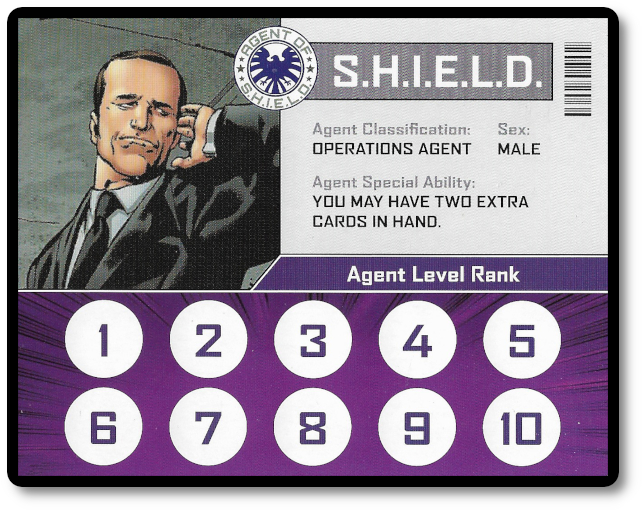
Before the game is played, each player should look at their starting hand and see if they have any “Ally,” “Item,” “Affiliation,” or “Power” cards noted as “Rank One” they want to play immediately.
Ally Cards
Each player may have one Ally card in play with their character during the game. When the player draws an Ally card, they can immediately put it in play, replacing any previously played Ally card. Ally cards give the player’s character additional bonuses. Players can change their Ally card anytime during the game but cannot trade Ally cards.
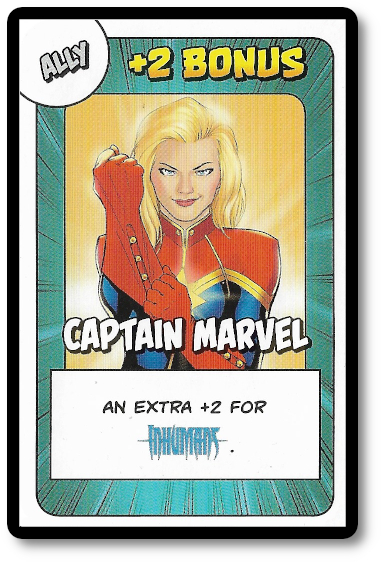
Ally cards can also be “sacrificed,” which allows the player to immediately avoid combat at the cost of discarding their Ally card. In addition, this automatically allows the player to “escape” without the need to randomly determine if they successfully bravely run away from a battle.
Item Cards
Item cards include equipment and treasure. A player can equip one “Headgear,” one “Armor,” one “Footgear,” one “Two-Handed,” or up to two “One-Handed” pieces of equipment to their character. Some cards, however, will allow the player to equip more items beyond these initial limitations.
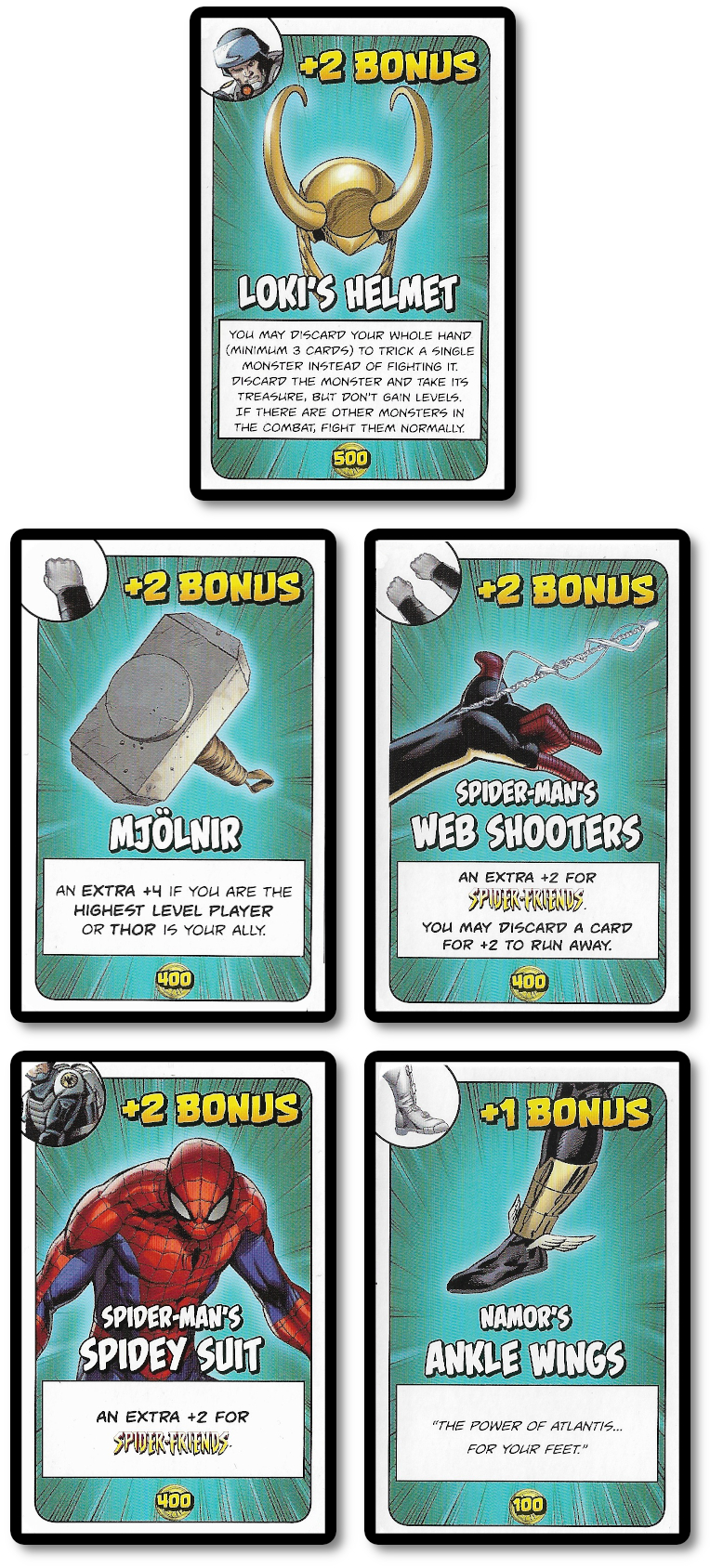
Treasure and items will have a gold value. If none is listed, it has no gold value, but that doesn’t mean it’s worthless. Players can sell items and treasure or even trade items currently in play with other players. At any point during the game (except when in combat), the player may sell items and treasure with a combined value of 1000 gold to gain a level up to level nine.
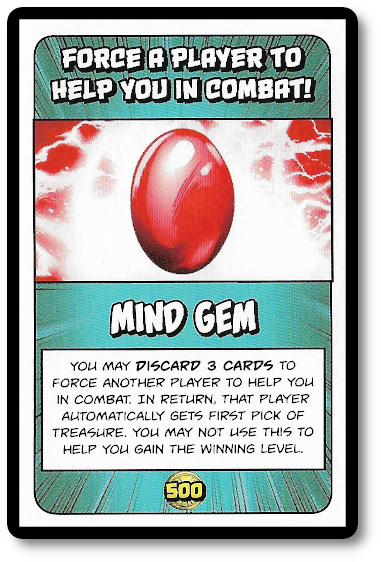
Affiliation Cards
Players can elect to join the Avengers, Inhumans, or Spider-Friends. Joining an affiliation is optional, but doing so allows the player to access additional powers and bonuses. A player may only belong to one affiliation at a time unless another card states otherwise, such as the “Team-Up” card.
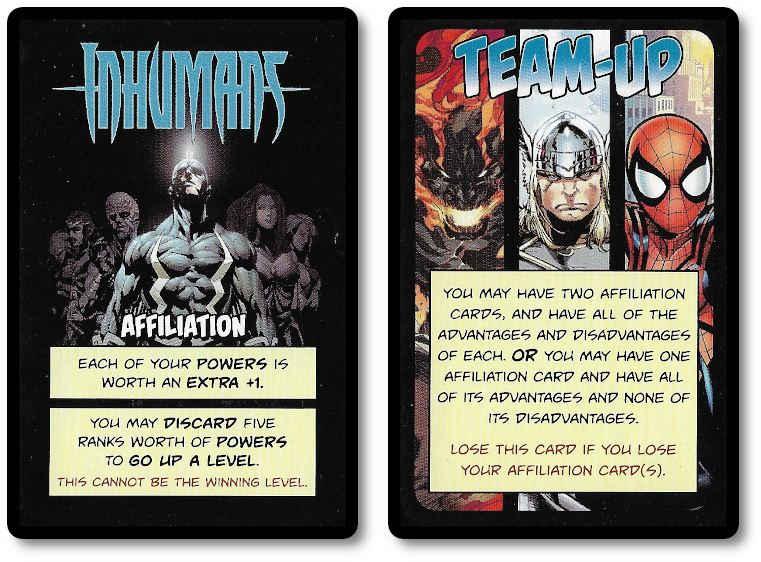
Power Cards
Power cards represent different super abilities. Powers are ranked. A player may equip as many Power cards as their like as long as the combined rank value of the Power cards does not exceed their character’s current level. This also means that a player might have to discard Power cards in play if their character loses a level.
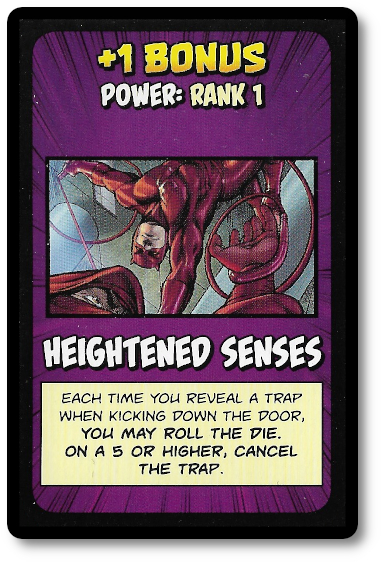
Into Battle!
Munchkin Marvel is played in turns with no set number of turns per game. A player’s turn is summarized here.
Any Time Actions
All players can take the following actions during the game regardless if it’s their turn or not.
- Discard an Affiliation card
- Play “Go Up a Level” or an Ally card
- Play a “Trap” card
All players can take the following actions during the game regardless if it’s their turn or not, but only if they are not in combat.
- Trade items with another player
- Change equipped items
- Play a card just received
All players at any time during their turn can take the following actions.
- Play a new Affiliation card
- Sell items for levels
- Play an Item card (with some restrictions during combat)
Step One: Kick Open the Door
The player draws the top Door card and places it in front of them face-up. They should now read it out loud.
- If the card is a “Monster,” immediately enter combat
- If the card is a “Trap,” resolve immediately and then discard
- If the card is any other than a Monster or a Trap, the player may keep it in their hand or play it immediately
Step Two: Look for Trouble or Loot the Room
If the player did not encounter a monster in step one, they could play a Monster card from their hand now and immediately enter combat.
Or, if the player likes, they can loot the room by drawing another Door card and putting it immediately in their hand, not showing it to their opponents.
Step Three: Charity
If the player now has more than five cards in their hand, they must either play as many as possible to reduce the number of cards in their hand to no more than five or give cards to the opponent who currently has the lowest level. If the player is the lowest leveled character currently in the game, they discard down to five cards if they cannot play any.
This ends the player’s turn. The next player now takes their turn.
Combat and Treasure
Players will enter combat with their character if they encounter a Monster. The outcome of combat is determined by comparing the Monster card’s combat strength to the player’s character’s combat strength. Combat strength for a character is determined by adding up any bonuses from powers items, allies, affiliations, plus the current level of the character. In addition, penalties reduce the character’s combat strength.
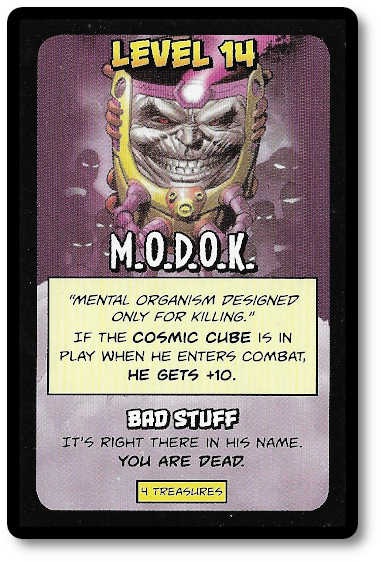
Opponents can increase the combat strength of a monster by playing cards to it, making even the weakest monster in the game a potential threat. Opponents can even add additional monsters to combat and traps.
A player can ask for help during combat if they don’t believe they can be victorious alone. Only one opponent can help the player during combat, but the player can ask whomever they like and continue to ask until someone agrees to help or everyone agrees not to lend a hand. However, it should be noted that any opponent can play a card during combat that might or might not help the player. When asking for help, a bribe is in order, and a deal must be struck. The particulars of the deal are up to the players but must be done openly at the table. Offers could include picking treasure first, offering cards in play and in the player’s hand. Opponents who help add their own combat strength to the players, with all noted bonuses.
If the player’s total combat strength (along with any bonuses from helping opponents) is greater than the monster’s, they win. Their character goes up a level per defeated monster and draws the noted number of Treasure cards indicated on the Monster card. If an opponent helped, place the Treasure cards face-up so they can see the spoils, too. Of course, if the player defeats a monster using some cards or special powers, they might not get a level or treasure.
If the player’s total combat strength (along with any bonuses) is equal to or lesser than the monster’s, they have lost and must now run away. They can discard an Ally to do so immediately and successfully avoid the bad stuff. Otherwise, they roll the six-sided die. If the rolled result is a five or a six, the player has successfully run away. No treasure or levels are earned, and if there is a penalty, it’ll be minor. It should also be noted that players and their helpers must all run from the monsters, including if there is more than one.
If the player does not roll the required number, the noted “Bad Stuff” on the Monster card is read aloud and resolved. This could mean a reduction in cards, loss of equipment, levels, and even death.
If the player’s character does die, they keep their Affiliation cards, Power cards, and level. However, they lose their equipment and all the cards in their hand. Opponents can now look at and take these cards into their own hand, thus looting the corpse of the dead character. At the start of the player’s next turn, their character miraculously comes back to life, and they draw a total of four cards from the Door and Treasure decks for a total of eight cards.
Victory!
The game continues, as noted above, with players losing and earning levels. When a player ends their turn by obtaining level 10 due to successfully defeating a monster, they win the game.
Game Variants
Any Munchkin game in the series can be combined with other Munchkin games, including expansions and all base sets. Game rules won’t change, but there will be a good deal more cards to play with.
If ending the game at level 10 is considered boring, there are rules that set the victory condition to level 20.
Finally, a Munchkin game could take up to two hours to complete, which is pretty insane considering how simple this game is. If a faster game is in order, rules are provided that removes some of the randomnesses and provides additional control to the players to determine encounters.
To learn more about Munchkin Marvel, visit the game’s webpage.
Final Word
 The Child Geeks, who all but a few were already familiar with the Munchkin games, tried and enjoyed this new version. According to one Child Geek, “I like the characters, and all my favorite superheroes are here. I think I like this better than the other games I’ve played, but I’m also pretty sure I just like superheroes more than dragons and axes.” Another Child Geek said, “If you know how to play Munchkin, you can play this game right away. I like the new theme and like how everything feels like a movie.” Those Child Geeks who had not played Munchkin before found the game to be easy to learn and fun to play. The result was all the Child Geeks, regardless of their personal history with the game to date, giving Munchkin Marvel their full approval.
The Child Geeks, who all but a few were already familiar with the Munchkin games, tried and enjoyed this new version. According to one Child Geek, “I like the characters, and all my favorite superheroes are here. I think I like this better than the other games I’ve played, but I’m also pretty sure I just like superheroes more than dragons and axes.” Another Child Geek said, “If you know how to play Munchkin, you can play this game right away. I like the new theme and like how everything feels like a movie.” Those Child Geeks who had not played Munchkin before found the game to be easy to learn and fun to play. The result was all the Child Geeks, regardless of their personal history with the game to date, giving Munchkin Marvel their full approval.
 The Parent Geeks also enjoyed the game, finding it to be just as easy to pick up and play as the Child Geeks. Plus, there were a surprising lot of Parent Geeks who were very geeky about superheroes, which you just know made them all the more open to the game itself. According to one Parent Geek, “I like the new theme, and the game works great with it. I can’t help that the game feels a lot like a comic book adventure. I had a blast.” Another Parent Geek said, “It’s Munchkin, which I know very well, with superheroes and such. I cannot say I find it overly imaginative or even new, but I enjoyed it. The new theme made an old game feel fresh again.” When the last supervillain was behind bars, the Parent Geeks awarded themselves medals, including one for Munchkin Marvel.
The Parent Geeks also enjoyed the game, finding it to be just as easy to pick up and play as the Child Geeks. Plus, there were a surprising lot of Parent Geeks who were very geeky about superheroes, which you just know made them all the more open to the game itself. According to one Parent Geek, “I like the new theme, and the game works great with it. I can’t help that the game feels a lot like a comic book adventure. I had a blast.” Another Parent Geek said, “It’s Munchkin, which I know very well, with superheroes and such. I cannot say I find it overly imaginative or even new, but I enjoyed it. The new theme made an old game feel fresh again.” When the last supervillain was behind bars, the Parent Geeks awarded themselves medals, including one for Munchkin Marvel.
 The Gamer Geeks liked the new theme and found the game the same as every other Munchkin game. According to one Gamer Geek, “I cannot judge this game as new by any means. It’s Munchkin with a new theme. Same rules. Same game flow. Same length of time at the table. I award it full points for finally bringing in Marvel, but no points for originality. It continues to be a game I find both unappealing but one I’ll always play.” Another Gamer Geek said, “New theme, same old game. I cannot get excited about it, but I cannot be too critical of it, either. This version of Munchkin follows the same winning script as all the others that came before it and the many that will come after. It’s Munchkin, and I’ll leave it at that.” When all the votes were in, the Gamer Geeks gave Munchkin Marvel mixed approval. If the Gamer Geek liked or loved Munchkin, it received two thumbs up. If not, well, you know the rest…
The Gamer Geeks liked the new theme and found the game the same as every other Munchkin game. According to one Gamer Geek, “I cannot judge this game as new by any means. It’s Munchkin with a new theme. Same rules. Same game flow. Same length of time at the table. I award it full points for finally bringing in Marvel, but no points for originality. It continues to be a game I find both unappealing but one I’ll always play.” Another Gamer Geek said, “New theme, same old game. I cannot get excited about it, but I cannot be too critical of it, either. This version of Munchkin follows the same winning script as all the others that came before it and the many that will come after. It’s Munchkin, and I’ll leave it at that.” When all the votes were in, the Gamer Geeks gave Munchkin Marvel mixed approval. If the Gamer Geek liked or loved Munchkin, it received two thumbs up. If not, well, you know the rest…
 I’ve been playing board, dice, and card games for a long, long time. Munchkin was one of those games you just “had to try” before you were considered a “gamer” in the circles I traveled in. And for a long time, I enjoyed the game. It has always provided interesting character interaction, decision making, and customization that I did then and still find appealing. However, if you played one Munchkin, you’ve played them all. In the same way, if you’ve played one game of Fluxx, you’ve played them all (with the exception being Cthulhu Fluxx which is the only Fluxx game I have ever really enjoyed, is worth your time, and I still play regularly). Seriously, there is a lot of Munchkin out there. Take a look at the growing list of Munchkin games on Board Game Geek or point your browser to the official Munchkin website.
I’ve been playing board, dice, and card games for a long, long time. Munchkin was one of those games you just “had to try” before you were considered a “gamer” in the circles I traveled in. And for a long time, I enjoyed the game. It has always provided interesting character interaction, decision making, and customization that I did then and still find appealing. However, if you played one Munchkin, you’ve played them all. In the same way, if you’ve played one game of Fluxx, you’ve played them all (with the exception being Cthulhu Fluxx which is the only Fluxx game I have ever really enjoyed, is worth your time, and I still play regularly). Seriously, there is a lot of Munchkin out there. Take a look at the growing list of Munchkin games on Board Game Geek or point your browser to the official Munchkin website.
Is there ever too much Munchkin? Oh, hell yes, but it has a loyal following. It’s still considered an excellent “gateway game” and is always seen at gaming conventions. It remains a solid filler and a go-to game for many who want to get something on the table but don’t necessarily want a game that takes a lot of their brain. This is not to say Munchkin doesn’t require you to think, but it’s a no-brainer for those who enjoy the gaming hobby.
And this is where it becomes difficult to be objective about the game rather than fully and transparently subjective. So, first, let me say that Munchkin Marvel is solid. The rules are the same as every other Munchkin game and will be easy to pick up and play for those already familiar with this game series or lucky enough to try it for the first time. So, there you go—a winning Munchkin game in as much as every other Munchkin game that has and will ever exist.
That was me being objective.
Subjectively, this is Munchkin. Nothing else. Nothing more. Nothing new. It’s the same game with a new paint job. If I painted your office a different color, would it be a different office? Heck no. The same goes for this game. Instead of fantasy, space, horror, Oz, hipsters, sharks, aliens, dragons, and just about every other genre you can think of, this one features Marvel heroes and villains, which is super cool if you enjoy Marvel (and don’t even get me started on the ridiculous debates I overheard about DC versus Marvel whilst playing this game… our hobby affords us a lot of free time to consider worthless arguments, apparently). If you don’t like Marvel, will you like this game? Sure, if you like Munchkin. If you don’t like Munchkin, I doubt any candy-coated theme sprayed on the box will change your mind. But hey, that’s me being subjective.
Is Munchkin Marvel for you? Goodness, I have no idea. I can say, without the slightest bit of hesitation, if you love Munchkin, prepare to gush all over this game, especially if you like superheroes and villains in tights and capes. If you don’t like either, well, avoid it. Of course, if you have never played a Munchkin game and are super big into the superhero movies available today, then you deserve to treat yourself to Munchkin Marvel. Excelsior!
This game was given to Father Geek as a review copy. Father Geek was not paid, bribed, wined, dined, or threatened in vain hopes of influencing this review. Such is the statuesque and legendary integrity of Father Geek.



